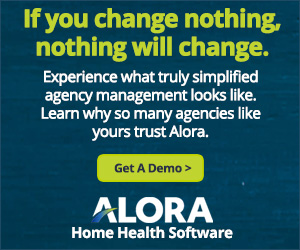
05 Aug Strong Onboarding to Drive Staff Retention for Home Health Agencies
Building strong onboarding programs for staff in home health care can be the difference
The Pain Point of Staffing
Healthcare is one of the biggest, if not the biggest, employers in the United States. Even before the pandemic, finding engaged and qualified staff, was an ongoing challenge for agencies operating in all aspects and areas of home health care. The pandemic has since introduced new obstacles and difficulties with recruitment and staff retention for home health agencies.
Competent staff is the backbone of a home health agency. Without dependable, committed, and qualified staff, the integrity of a home health agency’s mission statement and values cannot be maintained. The inability to onboard and retain the right staff for the company impacts multiple areas of performance.
- Prevents admission of new patients due to lack of available caregivers
- Reduce the quality of care of established patients
- Turning patients away impacts referral sources that may seek other agencies
- Short staffing increases staff turnover and frustration
- Rapid turnover and low staffing ratios increase error potential
- Inferior patient care
- Increase onboarding and hiring costs for the agency
- Decreased patient survey outcomes which impact reimbursement
Although all HHA’s are committed to providing excellent patient care, the work culture may be a variable that is overlooked when onboarding new staff. Home health agencies are desperate to onboard staff because all aspects of care depend on the availability of competent staff. The goal is to assemble a staff of qualified individuals that thrive together in a culture that reflects your agency’s mission statement.
Cultivating a Culture of Caring
Finding the right employee for your agency’s culture and mission is important to both your patients and your overall team. In today’s employment culture, there are so many options and open positions. Employees are mobile and move about without serious repercussions due to the sheer number of available positions. If your company culture does not support them in ways beyond financial then it is possible that they will continue their search. People stay in jobs where they feel they are respected, and their contributions are valuable. Money alone will not make them stay in the job, or even the field. Basic human needs can and should be addressed in the company hierarchy, often at little additional cost to the company. Some of the possible staff needs that could be addressed in some way by the agency include the following.
- Certainty or security
- Variety
- Significance
- Connection
- Growth
- Contribution
Not all needs can be met, but any effort made to address as many as possible will be an investment in your human resources that will ultimately yield great returns for your investment.
Security can mean offering discounts on insurances and aligning with other programs such as AFLAC if the agency cannot provide extensive benefits. It could mean guaranteeing a certain number of hours or limiting the daily mileage.
Variety may mean having different patient categories that direct support professionals or similar could apply to work with certain populations.
Significance is a significant human need. Design of plan in which team members feel valued and that the work they do is important. Make sure your employees feel seen, heard, and appreciated, and develop a consistent and committed action plan for this endeavor.
Connection may mean designing a peer-support or bi-weekly check-in to measure the satisfaction “pulse” of the staff in the field. It could be as simple as a questionnaire that requires yes or no answers and is sent to the immediate supervisor who responds with support if a certain percentage of answers are no.
Offering opportunities for growth within the company may mean offering tuition or in-house education for specialty populations. Explore the possibility of the CNA Apprentice Program for career advancement for interested employees. Growth is as important to the employee as it is to the business.
An agency’s mission statement should illustrate and define the importance of service to others as a contribution to building a better world. An agency must walk the walk as well as talk the talk. An agency that conducts business with its core principles front and center leads with purpose and meaning. These actions in turn instill pride and a sense of dignity in the expanded team of employees.
The human resource department manages human resources. Valuable, important, living, breathing beings are the face and backbone of your agency.
Determine what metrics work for your agency and what questions need to be answered. Use personality inventories or employee screening tests that fit your needs to find employees that represent the values of your agency.
Develop a Home Health Agency Recruiting Strategy
First and foremost, try to promote from within from existing employees. Ask current employees for recommendations or referrals. Consider consulting with a professional staffing agency. Post the jobs and develop a recruiting (and retention) strategy that works for your company.
A recruiting strategy can be as simple as an organized and efficient checklist that is followed with fidelity for each candidate. There should be pre-interview tasks that can rule out candidates or put them on the shortlist.
The first step is to review applications and resumes for accuracy and thoroughness.
- Resume or written application
- Written application
- Reference checks
- Background checks
- License checks if appropriate
Consider the legal and ethical consideration of candidate social media review as part of the hiring review process (A Harris Poll of HR professionals in 2017 revealed that 70 of employers used social media review to screen potential candidates).
Keep in mind that the best applicant on paper may not be the best individual for your team. Use Socratic questions for original and unrehearsed answers.
The following questions should be asked as part of the agency’s recruiting strategy.
- Can they do the job they are being hired for?
- Will they be with the company long-term and what are obstacles to this?
- Are they a good fit with the current team culture?
- Does their in-person presentation match their resume?
Develop a list of important soft skills you are looking for in a potential employee.
- Observation
- Decision Making
- Organization
- Empathy
- Setting boundaries
Hire Slow and Fire Fast
By implementing the first principle consistently and with fidelity, the second principle is less likely necessary. The goal of the interview is a fair and realistic exchange of information for both the agency and the potential employee. This is difficult to do because both parties are putting their best foot forward so take measures to present an accurate and fair description of the job and expectations.
Always provide a realistic portrayal of the job description. Provide as much detail as possible.
Companies are desperate to fill open positions but should design a checklist that includes a pause button. Agencies must design a hiring checklist that represents both the professional qualifications necessary but also the soft skills that represent potential that aligns with the company’s mission statement.
All agencies should have an onboarding checklist, this is the beginning of a relationship with an individual you are training to be a long-term team member.
When it becomes clear that the employee is not a good fit for your company, be decisive and cut ties with the employee. Instituting a probationary period as part of your employee recruitment and retention plan will build in time to evaluate, support, and/or ultimately cut ties with an employee that does not meet the company standards of care.
Develop a Strategy to Determine if You’ve Hired the Right Person
Home health staff often work independently in the home without direct supervision. This is a big gap to close but one worthy of the effort. One suggestion is to design a daily e-mail for 30 days in which the employee sends a brief update on how their day was and any challenges they experienced, and an opportunity to ask questions. This is an efficient way to check the “performance and experience” pulse of your new hire.
Leading with Vision
It has been said that people will stay at a job with less pay if it has more tangible and intangible benefits such as comradery and staff morale. Sign-on bonuses might get them in the door but encouraging and supportive team morale keeps them working happily.
A culture that promotes staff satisfaction and growth is a big part of keeping employees happy and motivated in your company.
Although the process begins with hiring the right people, it does not end there. The employer-employee relationship needs nurturing and care just like any other relationship. Just as a farmer tends his garden from planting to harvest, the expectations of leadership are not different. The goal of hiring is to keep qualified employees for the long haul and not just as a body taking space, but as an enthusiastic representative of the agency’s mission.
Read additional blogs on Home Health Staff Retention:
- Boosting job satisfaction to retain home health nurses
- Homecare agency work/life balance tips for clinicians
- Caregiver training, getting home health nurses off to a good start
- Dealing with the shortage of caregivers in homecare
- Ten best ways to show caregivers appreciation
- Preventing caregiver turnover in home health
- Creating job postings to attract nurses to your home health agency
- Five facts about caregiver burnout that will startle you
- The four foundations of improved staff retention in home care
- Being personable – how your agency can stand out

Alora provides agencies with a complete solution for home health agency workflow. When software is easy to use, caregivers and administrators are happier, and work more efficiently. With Alora, the power of simplicity can make the difference for your patients and your staff



No Comments